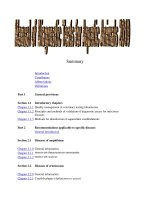Report: "rotifer food for aquatic animals" potx
Bạn đang xem bản rút gọn của tài liệu. Xem và tải ngay bản đầy đủ của tài liệu tại đây (725.6 KB, 25 trang )
1
Body size variation among
strains of the Rotifer
Brachionus plicatilis
The United states – israel Binational Agriculture
Reseach and Development Fund (BARD)
2
I. INTRODUCTION
Rotifer usefulness in aquaculture
Problem cosidered: size
This subject: Body size
variation among strains of the Rotifer
Brachionus plicatilis
The object of this work: 3
3
II. Methods and materials
The 13 strains of Rotifer aren’t
genetic non-relationship.
Laboratary conditions
Time: 1 year
4
5
1. Standard pre-experimetnal
procedure
After 3 days of
exponential growth, 200
females were removed
to repeat the procedure
After another 3 days of
exponential growth,
preserved for
measuring or initiate
other experiment
200
females
200
ml of
IOM
+ SF
S
E
6
2. Determinate body size
Measuring body
size on 50 adult
females
Body size: lorica
length and
width
Tool: an ocular
micrometer
an ocular micrometer
7
3. Comparation of reproductive
rates among strains
Consist 3
steps:
Pre-
experemental
conditions
Isolated singly
Count and
calculate
•
Population
growth rate
(r):
t
NoNt
r
lnln −
=
8
4. Size of a female over her
lifespan (McK8_3 days)
Collecting neonates
Cultivation neonates
Samples preservation procedure
Measuring lorica size
9
5. The dietary effects on
lorica size
Other 6 diets were used
Special culture conditions
Transfer to new culture condition
Samples were culture in SE
Preserve
10
6. The effects of temperature,
salinity and rotifer strain
A factorial experemental design was
used
Transfer to standard pre-experemental
conditions (after 7 days)
After 6 days of growth, preserve and
measure
11
III. Result
1. The range of lorica sizes
The range of lorica sizes among strains
is large
High correlation level between lorica
length and width (r = 0.974)
The reproduction rate depends on
rotifer strain
12
2. Size of a female over the
lifetime
The sizes grow
rapidly from
neonate to
adulthood
The growth
curve isn’t
smooth
The breeding
causes the
growth rate to
slow
13
3. Effect level of enviromental
conditions on lorica size
Diets effect on lorica size is small
14
4. The effect of temperature and
salinity
Salinity general effects on other
rotifer strains
Temperature special effects on other
rotifer strains
Rotifers tended to be smaller at higher
salinities and temperature for all
strains
15
16
5. Main effects and interactions
of salinity, temperature and
rotifer strain on lorica length
Lorica size is a characteristic that is
largely genetically determined
17
III. DISCUSSION
1. Range of lorica size
The other examinations suggest that
the lorica size is a wide range:
Samples collected from serveral
different locations by Ahlstrom
The range for laboratory-cultivated
is smaller than samples collected from
nature
18
2. Dietary effects
Type of diet has only small influence
on adult female body size (Fukusho
& Iwamoto and Yufera)
19
3. The effects of temperature
The effects of temperature on the
body size are entirely dependent on
strain type:
The respones of all strains for
temperature change
20
The role of temperature in
cyclomorphosis was initiated by
Fukusho and Iwamoto
21
Rotifer body size is
primarily geneticaliy determined,
not great influenced by
enviromental conditions
22
IV. Conclusion
Inappropriately sized larval prey
redures larval growth rate and
increases mortality
Selection of suitable rotifer
size is entirely feasible
The variety of rotifer size
and “enrichment” should improve the
reliability and usefulness of rotifer
in aquaculture
23
24
25









